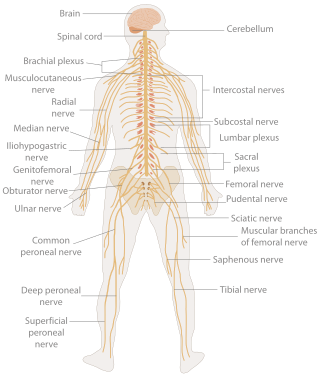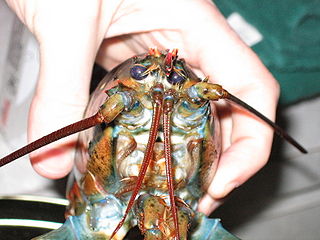
In biology, the nervous system is the highly complex part of an animal that coordinates its actions and sensory information by transmitting signals to and from different parts of its body. The nervous system detects environmental changes that impact the body, then works in tandem with the endocrine system to respond to such events. Nervous tissue first arose in wormlike organisms about 550 to 600 million years ago. In vertebrates, it consists of two main parts, the central nervous system (CNS) and the peripheral nervous system (PNS). The CNS consists of the brain and spinal cord. The PNS consists mainly of nerves, which are enclosed bundles of the long fibers, or axons, that connect the CNS to every other part of the body. Nerves that transmit signals from the brain are called motor nerves (efferent), while those nerves that transmit information from the body to the CNS are called sensory nerves (afferent). The PNS is divided into two separate subsystems, the somatic and autonomic, nervous systems. The autonomic nervous system is further subdivided into the sympathetic, parasympathetic and enteric nervous systems. The sympathetic nervous system is activated in cases of emergencies to mobilize energy, while the parasympathetic nervous system is activated when organisms are in a relaxed state. The enteric nervous system functions to control the gastrointestinal system. Nerves that exit from the brain are called cranial nerves while those exiting from the spinal cord are called spinal nerves.
Professor Geoffrey Alan Parker FRS is an emeritus professor of biology at the University of Liverpool and the 2008 recipient of the Darwin Medal. Parker has been called "the professional's professional".

The caridoid escape reaction, also known as lobstering or tail-flipping, is an innate escape behavior in marine and freshwater eucarid crustaceans such as lobsters, krill, shrimp and crayfish.

Sir John Bertrand Gurdon is a British developmental biologist, best known for his pioneering research in nuclear transplantation and cloning.

Sir Paul Patrick Gordon Bateson, was an English biologist with interests in ethology and phenotypic plasticity. Bateson was a professor at the University of Cambridge and served as president of the Zoological Society of London from 2004 to 2014.
Christopher Miles Perrins, is Emeritus Fellow of the Edward Grey Institute of Field Ornithology at the University of Oxford, Emeritus Fellow at Wolfson College, Oxford and His Majesty's Warden of the Swans since 1993.
Central pattern generators (CPGs) are self-organizing biological neural circuits that produce rhythmic outputs in the absence of rhythmic input. They are the source of the tightly-coupled patterns of neural activity that drive rhythmic and stereotyped motor behaviors like walking, swimming, breathing, or chewing. The ability to function without input from higher brain areas still requires modulatory inputs, and their outputs are not fixed. Flexibility in response to sensory input is a fundamental quality of CPG-driven behavior. To be classified as a rhythmic generator, a CPG requires:
- "two or more processes that interact such that each process sequentially increases and decreases, and
- that, as a result of this interaction, the system repeatedly returns to its starting condition."

Escape reflex, or escape behavior, is any kind of escape response found in an animal when it is presented with an unwanted stimulus. It is a simple reflectory reaction in response to stimuli indicative of danger, that initiates an escape motion of an animal. The escape response has been found to be processed in the telencephalon.
Anthony James Trewavas is Emeritus Professor in the School of Biological Sciences of the University of Edinburgh best known for his research in the fields of plant physiology and molecular biology. His research investigates plant behaviour.
In evolutionary psychology, people often speak of the four Fs which are said to be the four basic and most primal drives that animals are evolutionarily adapted to have, follow, and achieve: fighting, fleeing, feeding and mating.

Theodore Holmes Bullock is one of the founding fathers of neuroethology. During a career spanning nearly seven decades, this American academic was esteemed both as a pioneering and influential neuroscientist, examining the physiology and evolution of the nervous system across organizational levels, and as a champion of the comparative approach, studying species from nearly all major animal groups—coelenterates, annelids, arthropods, echinoderms, molluscs, and chordates.

There is a scientific debate which questions whether crustaceans experience pain. It is a complex mental state, with a distinct perceptual quality but also associated with suffering, which is an emotional state. Because of this complexity, the presence of pain in an animal, or another human for that matter, cannot be determined unambiguously using observational methods, but the conclusion that animals experience pain is often inferred on the basis of likely presence of phenomenal consciousness which is deduced from comparative brain physiology as well as physical and behavioural reactions.

Whether invertebrates can feel pain is a contentious issue. Although there are numerous definitions of pain, almost all involve two key components. First, nociception is required. This is the ability to detect noxious stimuli which evokes a reflex response that moves the entire animal, or the affected part of its body, away from the source of the stimulus. The concept of nociception does not necessarily imply any adverse, subjective feeling; it is a reflex action. The second component is the experience of "pain" itself, or suffering—i.e., the internal, emotional interpretation of the nociceptive experience. Pain is therefore a private, emotional experience. Pain cannot be directly measured in other animals, including other humans; responses to putatively painful stimuli can be measured, but not the experience itself. To address this problem when assessing the capacity of other species to experience pain, argument-by-analogy is used. This is based on the principle that if a non-human animal's responses to stimuli are similar to those of humans, it is likely to have had an analogous experience. It has been argued that if a pin is stuck in a chimpanzee's finger and they rapidly withdraw their hand, then argument-by-analogy implies that like humans, they felt pain. It has been questioned why the inference does not then follow that a cockroach experiences pain when it writhes after being stuck with a pin. This argument-by-analogy approach to the concept of pain in invertebrates has been followed by others.

Jonathan Felix Ashmore is a British physicist and Bernard Katz Professor of Biophysics at University College London.

Sir James Cuthbert Smith is an Emeritus Scientist at the Francis Crick Institute, Honorary Fellow of Christ's College, Cambridge and President of the Council at the Zoological Society of London.

Michael A. Häusser is a British scientist who is professor of Neuroscience, based in the Wolfson Institute for Biomedical Research at University College London (UCL).

Jonathon Noë Joseph Pines is Head of the Cancer Biology Division at the Institute of Cancer Research in London. He was formerly a senior group leader at the Gurdon Institute at the University of Cambridge.

Anne Jacqueline Ridley is a British biologist who is professor of Cell Biology and Head of School for Cellular and Molecular Medicine at the University of Bristol. She was previously a professor at King's College London.
Innes C. Cuthill is a professor of behavioural ecology at the University of Bristol. His main research interest is in camouflage, in particular how it evolves in response to the colour vision of other animals such as predators.













